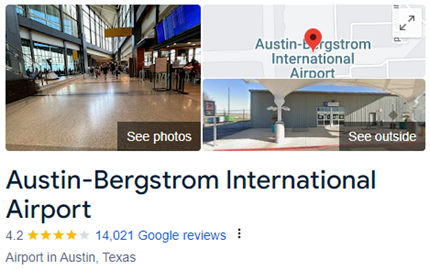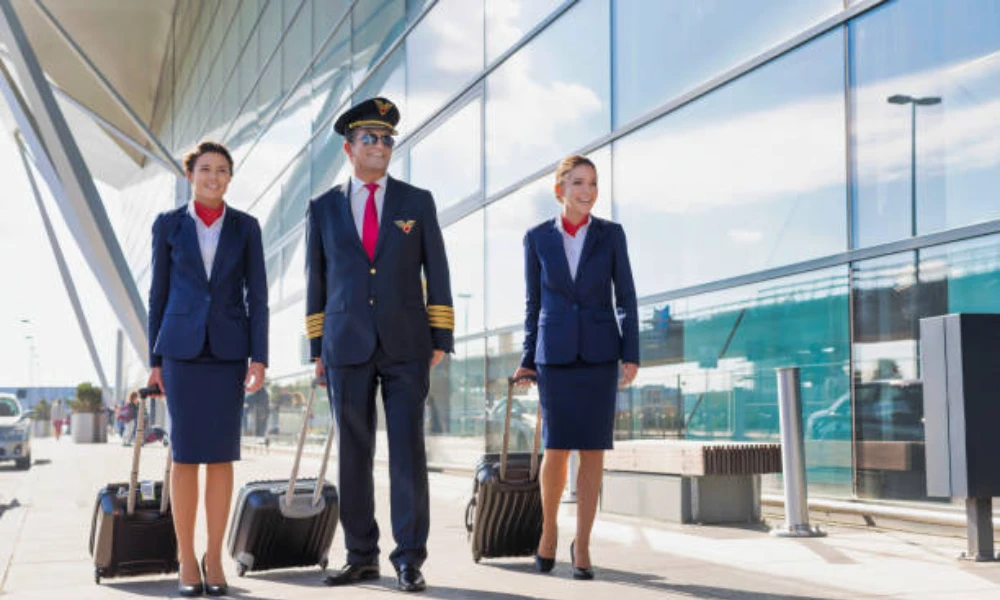
Austin–bergstrom
International Airport
Assistance Services
Jodogo simplifies your Austin–bergstrom international airport experience by offering meet-and-greet services, lounge access, and a luxurious limousine for added comfort during your airport transfer. Below are the inclusions covered in our service offerings.
- Meet and Greet at Arrival Gate
- Meet and greet post-immigration
- Wheelchair Assistance
- Porter service
- Assistance at check-in
- Fast Track through immigration
- Priority boarding
- Assistance with baggage handling
- Expedited Service Through Security
- Assistance for terminal transfer
- Escort until car pickup
- Liaise with Driver
- Escort to lounge
- Escort until departure gate
- Buggy Transfer
- Expedited service through Immigration
- Meet and greet at curbside at car drop-off

Austin-bergstrom International Airport Assistance
Airport in Austin, Texas
Address:3600 Presidential Blvd, Austin, TX 78719, United States
Austin–Bergstrom International Airport, or ABIA (IATA: AUS, ICAO: KAUS, FAA LID: AUS, formerly BSM), is an international airport in Austin, Texas, United States, serving the Greater Austin metropolitan area. Located about 5 miles (8 km) southeast of downtown Austin, it covers 4,242 acres (1,717 ha) and has two runways and three helipads. The airport lies on the site of what was Bergstrom Air Force Base, named after Captain John August Earl Bergstrom, an officer who was the first person from Austin to be killed in World War II. The base was decommissioned in the early 1990s, and the land reverted to the city, which used it to replace Robert Mueller Municipal Airport as Austin's main airport in 1999.
History Austin–Bergstrom International Airport
In 1942, the city of Austin purchased land and donated the land to the Federal government of the United States for a military installation, with the stipulation that the city would get the land back when the government no longer needed it. This land became Del Valle Army Air Base, or Del Valle Airfield. Del Valle Airfield was activated on September 19, 1942, on 3,000 acres (12 km2) leased from the City of Austin. The name of the base was changed to Bergstrom Army Airfield (AAF) in March 1943 in honor of Captain John August Earl Bergstrom, a reservist in the 19th Bombardment Group, who was killed at Clark Field, Philippines in 1941. He was the first Austinite killed in World War II. With the separation of the United States Air Force and United States Army in September 1947, the name again changed to Bergstrom Air Force Base. It would have this name until it was decommissioned in the early 1990s, with all military aviation ceasing in 1995 after more than 50 years.
As Austin was quickly outgrowing the old Robert Mueller Municipal Airport, the city began considering options for a new airport as early as 1971, when the Federal Aviation Administration proposed that Austin and San Antonio build a joint regional airport. That idea was rejected, as few Austinites supported driving halfway to San Antonio on Interstate 35 to catch a flight. Afterwards, the city submitted a proposal to the United States Air Force for joint use of Bergstrom Air Force Base in 1976. The Air Force rejected the proposal in 1978 as being too disruptive to its operations.
In the 1980s, neighborhoods around Mueller applied enough political pressure to force the city council to choose a site for a new airport from locations under consideration. In November 1987, voters approved a referendum designating a site near Manor. The city began acquiring the land but faced lawsuits from the Sierra Club and others concerned about the Manor location and its potential environmental impact.
The plans to construct a new airport at the Manor location were abandoned in 1991 when the Base Realignment and Closure Commission selected Bergstrom AFB for closure, and gave the nod to the city for the land and runways to be converted for use as a civilian airport. The USAF also agreed not to demolish the existing facilities, including the nearly pristine main runway. The city council decided to abandon the original plan to build the new airport near Manor, and resolved instead to move the airport to the Bergstrom site. The City of Austin hired John Almond—a civil engineer who had recently led the airport design team for the new airport expansion in San Jose, California—as Project Director for the new $585 million airport in Austin and to put together a team of engineers and contractors to accomplish the task. The issue of a $400 million bond referendum for a new airport owned and operated by the city was put to a public vote in May 1993 with a campaign managed by local public affairs consultant Don Martin and then-Mayor Bruce Todd and was approved by 63% of the vote. Groundbreaking for the new airport began in November 1994.

Future Austin–Bergstrom International Airport
In the coming years, AUS will be undergoing a major expansion with the goal of supporting 31 million passengers by 2040 (vs 11 million when opened in 1999). To accommodate this growth, AUS will optimize the current Barbara Jordan Terminal while building out a new midfield concourse. Additionally, two new taxiways will be constructed to accommodate the resulting increase in aircraft movements. The AUS 2040 Master Plan was finalized in 2019, but work was halted due to the COVID-19 pandemic and a new plan was launched in July 2021, which adapted the 2040 Master Plan to account for the effects of the pandemic.
The first phase of the plan will add remote hardstand gates served by buses from the main terminal. The southeast side of the terminal apron will be reconfigured to accommodate up to six aircraft boarding positions. Initially, buses will operate from a temporary gate 13 and the airport plans to build a more extensive busing gates facility near Gate 11. These hardstand gates are quick to build, but cause additional operational challenges, so they are seen as a short-term solution, and will only be used during peak hours.

Facilities Austin–Bergstrom International Airport
The Barbara Jordan Terminal is the airport's main terminal and has a total of 34 gates, six of which are capable of handling international flights. There are several restaurants and food concessions inside the terminal, all but two of which are located inside the secured gate areas of the terminal. The terminal also has a live music stage on which local bands perform in keeping with the spirit of Austin's proclamation as "The Live Music Capital of the World." A secondary terminal with three gates known as the South Terminal is used by ultra low-cost carriers Allegiant Air and Frontier Airlines.
The South Terminal is accessed from a separate entrance on the south side of the airport perimeter from Burleson Road; it cannot be accessed from either the main airport entrance from SH 71 or the Barbara Jordan terminal except by completely exiting the airport grounds. A shuttle bus runs between the two terminals and the trip between the terminals takes between 15 and 20 minutes. The facility has a retro look and passenger gates are not equipped with jet bridges; passengers walk under a covered walkway to board the aircraft by stairs.

Ground Transportation and Access Austin–Bergstrom International Airport
The Barbara Jordan Terminal has two parking garages and six surface lots. The Red Garage is directly connected to the terminal building and charges the highest prices. The Blue Garage is located northwest of the terminal and is connected to the Red Garage. The six surface parking lots, lettered B through G, are located north of the Blue Garage, and are branded as economy lots for their lower prices. The economy lots can be reached on foot or by shuttle buses.
Public transportation austin–Bergstrom International Airport:
Route 20, operated by the Capital Metropolitan Transportation Authority, operates from the arrivals level of the Barbara Jordan Terminal every 15 minutes. The route takes passengers through the East Riverside Corridor to Downtown and University of Texas at Austin before heading east along Manor Road.
Through the Project Connect plan, the airport is planned be the southern terminus of the Capital Metropolitan Transportation Authority Blue Line light rail, which will run through the East Riverside Corridor to Downtown Austin and The University of Texas at Austin as far north as North Lamar/US183. Blue Line construction costs are estimated at $1.3 billion and may be completed as early as 2029. The project (Proposition A) was approved by voters on November 3, 2020.
Rental Car Facility Austin–Bergstrom International Airport:
The airport offers a consolidated rent-a-car center (ConRAC) in a parking garage northeast of the Barbara Jordan Terminal and connected to the Red Garage. Ten rental car companies have passenger service counters on the second floor of the ConRAC, which can service up to 5,000 vehicles per day. The 1,600,000-square-foot (150,000 m2) facility opened in October 2015 and was built at a cost of US$162 million. A shuttle bus travels between the South Terminal and the ConRAC.

Why should you use JODOGO Airport Assistance?
- Avoid long lines and save time: JODOGO's Meet and Greet services help you bypass long queues at the airport, saving you valuable time and ensuring a seamless travel experience.
- Have a stress-free travel experience: JODOGO’s experienced and professional staff will handle every detail of your airport experience, allowing you to relax and enjoy your journey.
- Get personalized attention: JODOGO’s staff provides personalized attention and assistance, ensuring all your needs are met with care and efficiency.
- Enjoy a variety of services: JODOGO offers a variety of services to meet your needs, including Meet and Greet, porter assistance, fast-track check-in and security, and lounge access.
- Benefit from competitive rates: JODOGO offers competitive rates for its services, making it an affordable option for travelers. Enjoy 24/7 support—JODOGO is always available to assist you with your travel needs.
- Experience a smooth and efficient airport experience: JODOGO's staff is trained to deliver a smooth and efficient airport experience for every traveler.
- Feel confident and secure: JODOGO's knowledgeable and experienced staff ensures you are always in good hands.
- Relax and enjoy your trip: With JODOGO's assistance, you can relax and enjoy your journey, knowing your airport experience is fully taken care of.
FAQs for Airport Assistance
- Visit our website: Go to https://www.jodogoairportassist.com/airports/austin-bergstrom-international-airport.
- Fill out the online form: Provide your flight details, arrival/departure information, and desired services.
- Select your preferred payment method: We accept major credit cards and PayPal.
- Confirm your booking: Upon confirmation, you'll receive an email with all the details.
Yes, we offer VIP concierge services at Austin-bergstrom International Airport to provide a luxurious and personalized experience. Enjoy dedicated assistance with everything from luggage handling and expedited procedures to luxury transportation and personalized airport lounge access.
Additional Services:
- Austin-bergstrom airport VIP Services
- Austin-bergstrom Airport Fast Track
- Austin-bergstrom Airport Special Assistance
- Austin-bergstrom Airport Private Transfers
- Austin-bergstrom Airport Personal Assistant
Please note: This FAQ content is intended to provide a general overview of our services at Austin-bergstrom Airport. Visit our website for the latest information and specific details regarding our services and pricing.
For more information visit our website: https://www.jodogoairportassist.com/services
Related Airports

Redefining Airport Assistance Services, we at JODOGO aim to make your experience at the Narita International Airport (NRT) smooth, hassle-free, and one worth remembering. Our team, expertized at giving you a notable and luxurious VIP-like experience from the moment you step into the airport until you reach the destination, takes care of all the travel formalities, be it international or domestic, while you can sit back and relax. Narita International Airport, also known as Tokyo-Narita, formerly and originally known as New Tokyo International Airport, is constantly developing and expanding its facilities to provide high-quality services and enhanced passenger experience and is sure to cater to your every need, be it during your layover, transit, or stay in Japan.

Midland International Air and Space Port (IATA: MAF, ICAO: KMAF, FAA LID: MAF) (formerly Midland International Airport) is in the city limits of Midland, Texas, United States, about midway between Downtown Midland and Downtown Odessa, owned and operated by the City of Midland. In September 2014, it was licensed by the Federal Aviation Administration to serve commercial spaceflight. The airport has three airlines: two serving hubs with regional jets and one flying mainline jets. Southwest Airlines is the largest carrier at the airport. In 2012, 497,193 passengers were enplaned. The airport started as Sloan Field, a small airport started in 1927 by Samuel Addison Sloan. Sloan leased 220 acres of flat grassland from Clarence Scharbauer, a rancher. Sam Sloan died in a plane crash in 1929, and his brother, William Harvey Sloan,



